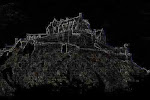I've read several places (most notably in the wonderful "Book of Common Ignorance") that the longer a language is around, the more it looses grammatical complexity and gains vocabulary size and density.
One good measure of this is the number and complexity of synonyms, since many of our words focus around the same thoughts (side-note, if any of you tell me the popular lie about certain Eskimos having many words for snow, I'll hit you over the head with a dictionary).
Japanese is a good example, it's been around a long, long time, and I wouldn't say it's a grammatically complex language at all, however, its vocabulary is pretty big, and it has lots and lots of synonyms, enough to garner its own wiki, here: Japanese Synonym Wiki
Some shining examples include:
The fact that there is actually a specific word (maitsuda) that one would only use to verbally tell an uncle something is not good, and this is only one note of aggravation in a symphony. Self-disappointed missing out gets its own word, as in "I slept late and missed out on ______" as does a word (haibaku) specifically for loosing a game or war.
other good examples from the website:
Many words for annoying.
Many words for investigating.
I am also fascinated by the fact that "image" has several different words, moving image (reflection, mirror, tv screen,cartoon), still image (picture), painted still image, and a sculpture. This would make art criticism rather interesting in some ways, and could make parts of the philosophy of semiotics very different. Please note that these aren't just equivalent to our words "painting" and "drawing" as these refer specifically to their operation as images, not just as their presence as works of art.
Also interesting from this philosophical perspective is a difference of borders.
Chromostereopsis
1 year ago

No comments:
Post a Comment